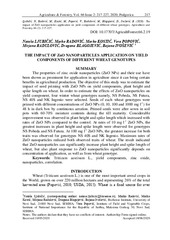Приказ основних података о документу
The impact of ZnO nanoparticles application on yield components of different wheat genotypes
| dc.creator | Ljubičić, Nataša | |
| dc.creator | Radović, M. | |
| dc.creator | Kostić, Marko | |
| dc.creator | Popović, Vera | |
| dc.creator | Radulović, M. | |
| dc.creator | Blagojević, D. | |
| dc.creator | Ivošević, Bojana | |
| dc.date.accessioned | 2021-04-26T19:57:13Z | |
| dc.date.available | 2021-04-26T19:57:13Z | |
| dc.date.issued | 2020 | |
| dc.identifier.issn | 0554-5579 | |
| dc.identifier.uri | http://fiver.ifvcns.rs/handle/123456789/2067 | |
| dc.description.abstract | The properties of zinc oxide nanoparticles (ZnO NPs) and their use have been shown as prominent for application in agriculture since it can bring certain benefits in agricultural production. The objective of this study was to estimate the impact of seed priming with ZnO NPs on yield components, plant height and spike length on wheat. In order to estimate the effects of ZnO nanoparticles on yield component, four winter wheat genotypes namely, NS Pobeda, NS Futura, NS 40S and NK Ingenio were selected. Seeds of each wheat genotypes were primed with different concentrations of ZnO NPs (0, 10, 100 and 1000 mg l-1) for 48 h in dark box by continuous aeration. Primed seeds were after sown in soil pots with 60-70% moisture contents during the till maturity. Considerable improvement was observed in plant height and spike length which increased with rates of ZnO NPs compared to the control. At rates of 10 mg l-1 ZnO NPs, the greatest increases in plant height and spike length were observed for genotypes NS Pobeda and NS Futura. At 100 mg l-1 ZnO NPs, the greatest increase for both traits was observed for genotypes NS 40S and NK Ingenio. Maximum rates of ZnO nanoparticles reduced both observed traits of wheat. The result indicated that ZnO nanoparticles can significantly increase plant height and spike length of wheat, but also plant response to ZnO nanoparticles significantly depends on concentration of application, as well as from wheat genotype. | en |
| dc.publisher | University of Montenegro | |
| dc.relation | info:eu-repo/grantAgreement/MESTD/inst-2020/200358/RS// | |
| dc.relation | info:eu-repo/grantAgreement/MESTD/inst-2020/200032/RS// | |
| dc.relation | info:eu-repo/grantAgreement/EC/H2020/810775/EU// | |
| dc.relation | info:eu-repo/grantAgreement/EC/H2020/639034/EU// | |
| dc.relation | Bilateralni projekat Crna Gora-Srbija: Alternativna žita i uljarice kao izvor zdravstveno bezbedne hrane i važna sirovina za proizvodnju biodizela (2019-2020) | |
| dc.relation | FAO project: Redesigning the exploitation of small grains genetic resources towards increased sustainability of grain-value chain and improved farmers’ livelihoods in Serbia and Bulgaria – GRAINEFIT; 2019-2022 | |
| dc.rights | openAccess | |
| dc.rights.uri | https://creativecommons.org/licenses/by/4.0/ | |
| dc.source | Agriculture & Forestry | |
| dc.subject | Correlation | en |
| dc.subject | Nanoparticles | en |
| dc.subject | Triticum aestivum L. | en |
| dc.subject | Yield components | en |
| dc.subject | Zinc oxide | en |
| dc.title | The impact of ZnO nanoparticles application on yield components of different wheat genotypes | en |
| dc.type | article | |
| dc.rights.license | BY | |
| dc.citation.epage | 227 | |
| dc.citation.issue | 2 | |
| dc.citation.other | 66(2): 217-227 | |
| dc.citation.spage | 217 | |
| dc.citation.volume | 66 | |
| dc.identifier.doi | 10.17707/AgricultForest.66.2.19 | |
| dc.identifier.fulltext | http://fiver.ifvcns.rs/bitstream/id/998/2064.pdf | |
| dc.identifier.scopus | 2-s2.0-85089565322 | |
| dc.type.version | publishedVersion |


